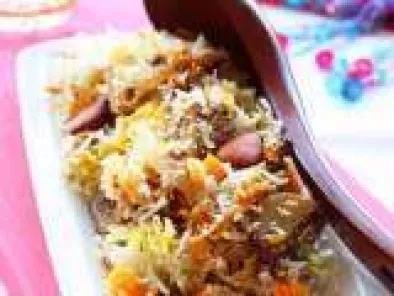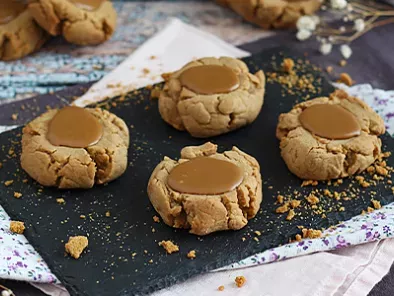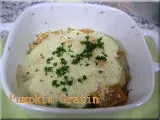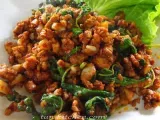Mughlai Apricot Biryani


In honour of all things royal wedding, I?m creating a banquet fit for kings and queens. Our party spread will be formed of rich, sweet and spicy dishes for us to present to our family and guests so they can ?ohh? and ?ahh? over it while we take all the credit for such an extravagant and mouth watering menu.
Biryani is a bit like a newborn kitten ? except you don?t cook nor eat newborn kittens. It requires heaps of concentration, patience and love.
Each individual component needs to be prepared to just the right level before the ingredients can be assembled in a harmonious fashion, and then gently steamed to create an insanely delicious smelling and tasting dish to fight over at the dinner table.

Swollen soaked saffron strands
In the last post we discussed the origins of Mughlai cuisine and what makes it so majestic, and this fruity, nutty aromatic rice is right on point. Juicy apricots and pineapples are layered up with fluffy rice, spicy potatoes, sweet onions, aromatic saffron and kewra water (screwpine extract).
Screwpine is the same plant that produces pandan and as the name suggests, kewra has a very distinct ?pine? incense aroma and a very slight vanilla flavour. It?s traditionally used in biryanis (among other rice dishes), meat curries, Indian desserts, baking and savoury gourd (melon) dishes.
I?m not going to lie to you, you are likely to do a double take when you see the ingredients list. Take courage, my recipe provides you with a straightforward process to follow to create a true masterpiece. In truth, the assembly of biryani is not unlike the process used to make lasagne ? it?s all in the preparation, so be prepared.
The following method is very detailed because I want to give you a complete guide full of handy hints and tips to make the perfect biryani for any occasion, and not only this one.

Mughlai Apricot Biryani
(serves 6, or 8 as part of a large meal) Ingredients:
400g basmati rice
340g baby new potatoes, cut into quarters 320g onions, sliced into thin strips
60g dried apricots, chopped, chopped into 2cm chunks
20g dried pineapple, chopped into 2cm chunks
20g whole almonds
20g whole pistachios
10g unsweetened desiccated coconut or 30g fresh coconut, grated
1 pinch saffron soaked in 4 tbsp hot water
1 tbsp kewra water
250ml hot water + more for boiling the rice and potatoes
4 tbsp oil or ghee
Salt
For the spicy yogurt mixure:
4 tbsp Greek yogurt
1 ½ tsp minced ginger 4 tbsp Greek yogurt
2 tsp minced chillies
1 tsp cinnamon powder
4 whole cloves
1 tsp ground green cardamom seeds (flowery, aromatic flavour)
¼ tsp ground black cardamom seeds (smoky, heady flavour)
¼ tsp whole fennel seeds
¼ tsp pomegranate seed powder (sharp, sour taste ? available in most Indian shops)
1/8 tsp ground mace
1 small pinch ground nutmeg
1 tsp salt
Method
1. Wash your rice 8-10 times in cold water. Allow to soak in a bowl of cold water for 30 minutes. Note: You?re washing the rice to remove the starch and promote fluffy grains when cooked. Soaking the rice helps even cooking of the rice through the tenderisation of each grain.
2. Meanwhile, boil the potatoes in a pan of salted boiling water until half-cooked. Drain and set aside. Note: Don?t overcook your potatoes because they?re going to go through another two cooking processes ? frying and steaming.
3. Soak the chopped apricots and pineapples in warm water and set aside.
4. Whisk together all of the ingredients for the spicy yogurt mixture and set aside. Note: We?re using this as a sauce to cook our potatoes in to keep them delicious and moist.
5. Heat the oil in a large non-stick pan (I used a wok) and add the part-cooked potatoes. Fry until golden all over. Remove from the pan with a slotted spoon, leaving the oil behind and drain on kitchen paper.
6. Mix the fried potatoes with the yogurt mixture and set aside. Note: Adding the hot potatoes to the yogurt mixture will allow them to soak up all of the spices.
7. Fry the slices of onion until golden in the same oil used to fry the potatoes. Remove from the pan with a slotted spoon, leaving the oil behind and drain on kitchen paper.
8. Next, fry the almonds and pistachios until slightly golden (do not over brown) in the same oil used to fry the potatoes and onions. Remove from the pan with a slotted spoon, leaving the oil behind and drain on kitchen paper. Note: We are using the same oil to get as much flavour into this biryani as possible ? if you used new oil each time, the flavours would just be thrown away.
9. Boil the rice in water seasoned with plenty of salt for just five minutes or until half-cooked. Drain and set aside. Note: We do not want to cook the rice too much because we?re going to gently finish cooking it with all of the other ingredients later.
9. Add the potato and yogurt mixture back into the pan of warm oil and cook for 4-5 minutes or until aromatic. Remove half of the potatoes from the pan and set aside, leaving half behind. Were now ready to start layering up the biryani.

10. Turn the heat off before you begin layering. Place enough rice over to potatoes to cover them. Spread on half of the onions, drained apricots and pineapples, coconut, nuts and spoon over half of the saffron water and kewra water. Cover with more rice, then potatoes and more rice.
11. Again, spread on half of the onions, drained apricots and pineapples, coconut, nuts and spoon over half of the saffron water and kewra water. Add 250ml boiling water (salted with 1 tsp salt).
12. Cover the biryani with foil and place a tight-fitting lid on top. Cook on a low heat for approximately 20 minutes. Check the rice at the halfway point ? it?s better to be safe than sorry. Note: We want the biryani to gently steam and a delicious golden (not burnt) crust to form on the bottom of the pan. This is a conventional way to cook biryani ? not a traditional way. I will go through traditional biryani cooking another time.
13. Remove the lid and gently fluff up the rice with a fork, taking care not to combine it too much. Beautiful, uneven colouring is characteristic of a good biryani.
I?ve detailed the biryani-making process as fully as I can, however if you feel I?ve missed anything please feel free to leave a comment or send me an email.

Serve with Melt in the Mouth Paneer Kofta, Shahi Paneer Stuffed Okra and other Mughlai treats I?ll be showing you soon.
Now let?s get down to business ? when are you having this royal Mughlai banquet and where is my invitation? I?ll be waiting for it.

KO Rasoi
Comments
Rate this recipe:
There are no comments!





